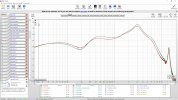Received mine yesterday. Really nice iem. Thx @amirm for the hint! First tried them with the big bore silicon tips.
Sound was good but some strange distortion in the highs with some instruments.
Then tried the memory foam tips and the sound got much more well rounded. Still a little too much bass and little to much highs.
Tried Maiky76 EQ. Sound balance was very accurate but these sharp q filters make the sound unnaturally and fatiguing in my opinion.
Same happens when DSP is used to make a sharp q correction for speakers.
Especially in low distortion transducers where distortion wont hide anything...
So i tried to find minimal low q filters to only remove the big frequency errors.
This is my current EAPO EQ. Great bass and none fatiguing natural sounding highs in my opinion.
Tweak it for your own liking especially the 2200 Hz gain.
Preamp: -5 dB
Filter: ON PK Fc 20 Hz Gain 3.88 dB Q 0.9
Filter: ON PK Fc 81.44 Hz Gain -2.05 dB Q 1.46
Filter: ON PK Fc 17000 Hz Gain -2.5 dB Q 1
Filter: ON PK Fc 2200 Hz Gain -2.5 dB Q 1
The standout feature of this iem is the seperation of bass und the rest of the band in my opinion.
Its crazy to listen to such a clean nice deep bass without influencing the rest of the spectrum.
Sound was good but some strange distortion in the highs with some instruments.
Then tried the memory foam tips and the sound got much more well rounded. Still a little too much bass and little to much highs.
Tried Maiky76 EQ. Sound balance was very accurate but these sharp q filters make the sound unnaturally and fatiguing in my opinion.
Same happens when DSP is used to make a sharp q correction for speakers.
Especially in low distortion transducers where distortion wont hide anything...
So i tried to find minimal low q filters to only remove the big frequency errors.
This is my current EAPO EQ. Great bass and none fatiguing natural sounding highs in my opinion.
Tweak it for your own liking especially the 2200 Hz gain.
Preamp: -5 dB
Filter: ON PK Fc 20 Hz Gain 3.88 dB Q 0.9
Filter: ON PK Fc 81.44 Hz Gain -2.05 dB Q 1.46
Filter: ON PK Fc 17000 Hz Gain -2.5 dB Q 1
Filter: ON PK Fc 2200 Hz Gain -2.5 dB Q 1
The standout feature of this iem is the seperation of bass und the rest of the band in my opinion.
Its crazy to listen to such a clean nice deep bass without influencing the rest of the spectrum.
Last edited:


